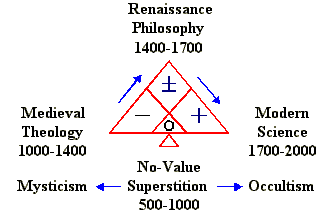
The philosophy of Trinityism has practical application in most, if not all branches of knowledge. The following is a concise, all-encompassing example of how it applies in theology, philosophy, science, psychology, sociology, history, politics, morality, education, and art. These are all diverse, yet all are unified by one symbolic structure.
We begin with the changing values in the history of Western, Christian, Caucasian Civilization. Its values have changed thru the balancing, cyclical trinity of spiritual-rational-sensual values between 1000-2000 A.D. This is verified by the paralleling sequential changes in the Medieval-Renaissance-Modern Ages, that had paralleling ages of theology-philosophy-science and their branching divinities-humanities-sciences. This changing trinity of values began with an emotive Dark Age of No-values that followed the end of the Roman Civilization in 500 A.D. This age of no common spiritual, rational, or sensual values was an emotive age of superstition; of emotional instinct, impulse, and compulsion; of mysticism-psychism-occultism, an age basically of no civilization.
The changing, balancing, cyclical values of Western Civilization may be explained, illustrated, related, developed and unified by the Trinity Structure shown below. It is a "Map" of Western Civilization, as well as the "Seasons" on a "Calendar of Human Change". Like a geographical map and seasons on a natural calendar, they enable the perception, prediction, and control of changing values on all ranges of society, from the individual, to society, to humanity.

________________________________________________________________________
0 - ± +
NO-VALUE AGE ——> MEDIEVAL AGE ——> RENAISSANCE AGE — —> MODERN AGE
________________________________________________________________________
VALUES:
Spirits God Man Nature
Emotive Spiritual Rational Sensual
Apathetic Altruistic Idealistic Realistic
LEARNING:
Emotional Intuitive Logical Empirical
No discipline Disciplined Self-disciplined Undisciplined
Non-function Believer Thinker Doer
WHAT IS TAUGHT:
Employment Theology Philosophy Science
Personal feeling Divinities Humanities Psychology
Ideology Bible Classics Statistics
MORALITY:
Amorality Morals Ethics Hedonism
Personal Religious Political Social
Natural law Duties Self-responsibility Rights
THE PERSON:
Instinct Spirit Mind Body
No-identity Character Personality Popularity
Apathetic Introvert Ambivert Extrovert
POLITICAL/SOCIAL:
Nihilism Autocracy Republic Democracy
Complacent Reactionary Conservative Radical
War Lord Aristocratic Hierarchical Egalitarian
ART:
Non-art Folk art Cultured art Commercial art
Primitive Divinities Humanities Naturalisms
Pornographic Mystical Idealistic Aesthetic
The Trinity Structure is a "Building block" of knowledge. It may be used to explain, illustrate, relate, develop, and unify most knowledge. Here it is applied to Western Civilization. The structure's triangles symbolize cycles within cycles, The pedestal symbolizes balancing changes between negative-neutral-positive values. The arrows symbolize the direction of changing values.
How changing spiritual-rational-sensual values in Western History parallel the basic Medieval-Renaissance-Modern trinity of values is evident in the listing of trinitized values below the structure. These values may be categorized under the title of almost any discipline; whether theology, philosophy, or science, to give a basic history of that discipline's changing values. This is evident below. The plus-neutral-minus signs, in the Trinity Structure and in the title of the listing, symbolize generic negative-neutral-positive material values, or spiritual-rational-sensual human values.
A true definition of words may be had by picking any word in a particular column and describing it by other words in that column, or by saying what a word is not in another column. Words from other columns would be inconsistent in a definition. The true meaning of words are inferred from the fact that words from the spiritual column are the antitheses of words from the sensual column, while words in the rational column are a synthesis of words from the spiritual and sensual columns.
If the Trinity Structure is connected to other Trinity structures, to make a pyramid structure of them, the Progressive Range Structure is made. The Progressive Ranges of Society include the Individual, Family, Group, City, Nation, Civilization, and Humanity. A principle that applies on one of these ranges applies on the other ranges. So in principle, what applies here to Western Civilization applies all other ranges of society. In other words the same principles of psychology that apply on the individual range, also apply to sociology on the family and group ranges, to politics on the city and national ranges, to history on the civilization range, and to philosophy on the humanity range.
Each branch of knowledge may be trinitized to manifest the balancing, cyclical changes of its knowledge. Each particular branch of knowledge may be explained, illustrated, related, developed and unified by the Trinity Structure. A book on any discipline could be written, based on such a listing of trinitized values. This unification makes the philosophy of Trinityism to be the basis for a Grand Unifying Theory for most, if not all knowledge.